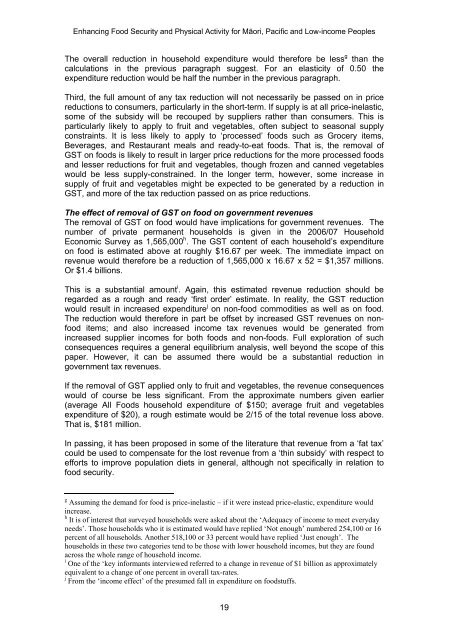enhancing food security and physical activity for maori, pacific and ...
enhancing food security and physical activity for maori, pacific and ...
enhancing food security and physical activity for maori, pacific and ...
- No tags were found...
You also want an ePaper? Increase the reach of your titles
YUMPU automatically turns print PDFs into web optimized ePapers that Google loves.
Enhancing Food Security <strong>and</strong> Physical Activity <strong>for</strong> Māori, Pacific <strong>and</strong> Low-income PeoplesThe overall reduction in household expenditure would there<strong>for</strong>e be less g than thecalculations in the previous paragraph suggest. For an elasticity of 0.50 theexpenditure reduction would be half the number in the previous paragraph.Third, the full amount of any tax reduction will not necessarily be passed on in pricereductions to consumers, particularly in the short-term. If supply is at all price-inelastic,some of the subsidy will be recouped by suppliers rather than consumers. This isparticularly likely to apply to fruit <strong>and</strong> vegetables, often subject to seasonal supplyconstraints. It is less likely to apply to ‘processed’ <strong>food</strong>s such as Grocery items,Beverages, <strong>and</strong> Restaurant meals <strong>and</strong> ready-to-eat <strong>food</strong>s. That is, the removal ofGST on <strong>food</strong>s is likely to result in larger price reductions <strong>for</strong> the more processed <strong>food</strong>s<strong>and</strong> lesser reductions <strong>for</strong> fruit <strong>and</strong> vegetables, though frozen <strong>and</strong> canned vegetableswould be less supply-constrained. In the longer term, however, some increase insupply of fruit <strong>and</strong> vegetables might be expected to be generated by a reduction inGST, <strong>and</strong> more of the tax reduction passed on as price reductions.The effect of removal of GST on <strong>food</strong> on government revenuesThe removal of GST on <strong>food</strong> would have implications <strong>for</strong> government revenues. Thenumber of private permanent households is given in the 2006/07 HouseholdEconomic Survey as 1,565,000 h . The GST content of each household’s expenditureon <strong>food</strong> is estimated above at roughly $16.67 per week. The immediate impact onrevenue would there<strong>for</strong>e be a reduction of 1,565,000 x 16.67 x 52 = $1,357 millions.Or $1.4 billions.This is a substantial amount i . Again, this estimated revenue reduction should beregarded as a rough <strong>and</strong> ready ‘first order’ estimate. In reality, the GST reductionwould result in increased expenditure j on non-<strong>food</strong> commodities as well as on <strong>food</strong>.The reduction would there<strong>for</strong>e in part be offset by increased GST revenues on non<strong>food</strong>items; <strong>and</strong> also increased income tax revenues would be generated fromincreased supplier incomes <strong>for</strong> both <strong>food</strong>s <strong>and</strong> non-<strong>food</strong>s. Full exploration of suchconsequences requires a general equilibrium analysis, well beyond the scope of thispaper. However, it can be assumed there would be a substantial reduction ingovernment tax revenues.If the removal of GST applied only to fruit <strong>and</strong> vegetables, the revenue consequenceswould of course be less significant. From the approximate numbers given earlier(average All Foods household expenditure of $150; average fruit <strong>and</strong> vegetablesexpenditure of $20), a rough estimate would be 2/15 of the total revenue loss above.That is, $181 million.In passing, it has been proposed in some of the literature that revenue from a ‘fat tax’could be used to compensate <strong>for</strong> the lost revenue from a ‘thin subsidy’ with respect toef<strong>for</strong>ts to improve population diets in general, although not specifically in relation to<strong>food</strong> <strong>security</strong>.g Assuming the dem<strong>and</strong> <strong>for</strong> <strong>food</strong> is price-inelastic – if it were instead price-elastic, expenditure wouldincrease.h It is of interest that surveyed households were asked about the ‘Adequacy of income to meet everydayneeds’. Those households who it is estimated would have replied ‘Not enough’ numbered 254,100 or 16percent of all households. Another 518,100 or 33 percent would have replied ‘Just enough’. Thehouseholds in these two categories tend to be those with lower household incomes, but they are foundacross the whole range of household income.i One of the ‘key in<strong>for</strong>mants interviewed referred to a change in revenue of $1 billion as approximatelyequivalent to a change of one percent in overall tax-rates.j From the ‘income effect’ of the presumed fall in expenditure on <strong>food</strong>stuffs.19
















